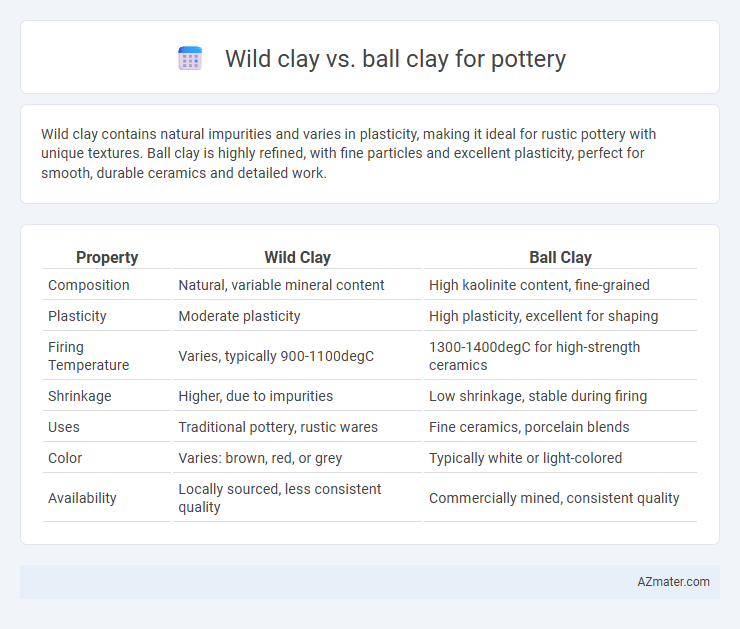Wild clay contains natural impurities and varies in plasticity, making it ideal for rustic pottery with unique textures. Ball clay is highly refined, with fine particles and excellent plasticity, perfect for smooth, durable ceramics and detailed work.
Table of Comparison
| Property | Wild Clay | Ball Clay |
|---|---|---|
| Composition | Natural, variable mineral content | High kaolinite content, fine-grained |
| Plasticity | Moderate plasticity | High plasticity, excellent for shaping |
| Firing Temperature | Varies, typically 900-1100degC | 1300-1400degC for high-strength ceramics |
| Shrinkage | Higher, due to impurities | Low shrinkage, stable during firing |
| Uses | Traditional pottery, rustic wares | Fine ceramics, porcelain blends |
| Color | Varies: brown, red, or grey | Typically white or light-colored |
| Availability | Locally sourced, less consistent quality | Commercially mined, consistent quality |
Understanding Wild Clay and Ball Clay
Wild clay, typically sourced from natural, unprocessed deposits, contains a mix of minerals and organic matter that influences its plasticity and firing characteristics, making it suitable for rustic, textured pottery. Ball clay, a highly refined and homogenized material, is prized for its fine particle size, high plasticity, and excellent binding properties, which enhance the strength and workability of the ceramic body. Understanding the mineral composition and physical properties of wild and ball clays helps potters choose the right clay type for specific pottery techniques and desired finishes.
Origins and Formation of Wild Clay
Wild clay originates from natural deposits found in riverbeds, forest floors, or exposed earth surfaces, where it forms through the weathering and erosion of rocks rich in minerals like kaolinite and montmorillonite. Unlike refined ball clay, which is typically mined from sedimentary deposits and undergoes processing to improve plasticity and strength, wild clay retains more organic materials and impurities, influencing its texture and firing properties. Understanding the geological formation of wild clay helps potters appreciate its variable composition and unique characteristics ideal for rustic or experimental pottery styles.
Geological Background of Ball Clay
Ball clay is a fine-grained, highly plastic sedimentary clay formed from the weathering and decomposition of feldspathic rocks, often found in tertiary basins with marine or freshwater depositional environments. Its unique geological formation results in a high kaolinite content combined with organic matter and mica, providing excellent plasticity and workability essential for pottery production. In contrast, wild clay typically exhibits less uniform composition and plasticity, as it is often sourced from heterogeneous, less mature geological deposits.
Chemical Composition: Wild Clay vs Ball Clay
Wild clay typically contains higher amounts of iron oxide and organic matter, resulting in a more variable chemical composition that affects its plasticity and firing color. Ball clay is known for its consistent chemical profile, with high kaolinite content and low impurities, providing superior plasticity and strength in pottery bodies. Understanding these differences in chemical composition is crucial for potters aiming to optimize workability and final ceramic quality.
Plasticity and Workability Differences
Wild clay exhibits lower plasticity than ball clay, resulting in less flexibility and higher shrinkage during drying and firing. Ball clay is highly plastic with fine particles, providing superior workability and allowing potters to shape intricate forms with ease. The enhanced plasticity of ball clay makes it ideal for blending with other clays to improve strength and reduce cracking in pottery.
Firing Temperatures and Thermal Behavior
Wild clay typically fires at higher temperatures ranging from 1200degC to 1300degC, exhibiting strong thermal stability and low shrinkage, making it suitable for stoneware and porcelain production. Ball clay, by contrast, fires at lower temperatures around 1100degC to 1150degC and has higher plasticity but greater shrinkage, often used in earthenware and as a blending agent to improve workability. The thermal behavior differences between wild and ball clays directly affect their application in pottery, with wild clay favoring durability at high heat and ball clay providing flexibility in shaping and firing cycles.
Color Variations in Finished Pottery
Wild clay often produces pottery with varied, earthy tones ranging from reddish-brown to muted gray due to its natural mineral composition, while ball clay typically results in smoother, more consistent colors like creamy white or light tan. The higher plasticity and finer particles in ball clay contribute to a more uniform surface finish and subtle color variations in glazed pottery. Potters seeking vibrant, unpredictable color effects may prefer wild clay for its natural inclusions and organic hues.
Processing and Preparation Techniques
Wild clay requires minimal processing, often involving simple cleaning to remove impurities like stones and organic matter before wedging. Ball clay undergoes extensive preparation, including thorough sieving, levigation, and sometimes blending with other clays to achieve consistent plasticity and fine particle size. The processing differences directly impact drying behavior and firing quality, with ball clay favored for its smooth texture and strength in pottery formulations.
Sustainability and Sourcing Considerations
Wild clay, often sourced locally from natural deposits, offers a more sustainable option due to minimal processing and lower transportation emissions compared to ball clay, which is typically mined in controlled environments with significant environmental impact. Ball clay, renowned for its plasticity and fine particle size, often requires intensive extraction methods and distant shipping, increasing its carbon footprint and raising ethical sourcing concerns. Prioritizing wild clay supports eco-friendly practices and reduces carbon emissions, while ball clay's sourcing demands scrutiny to ensure responsible mining and environmental compliance in pottery production.
Choosing the Right Clay for Your Pottery Project
Wild clay contains natural impurities like sand and organic matter, providing a coarse texture ideal for rustic pottery and sculptural work. Ball clay is highly plastic, fine-grained, and smooth, making it perfect for detailed, delicate ware and functional ceramics requiring strength and refined surfaces. Selecting clay depends on project goals: use wild clay for earthy aesthetics and texture, while ball clay suits precision casting and high-quality finishes.

Infographic: Wild clay vs Ball clay for Pottery
 azmater.com
azmater.com